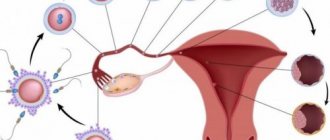- home
- Bleeding
The appearance of traces of blood on a woman’s underwear is quite common. Every month the endometrial layer is renewed. The old layer is rejected and excreted from the body with bloody discharge. It is more difficult when the appearance of blood is not associated with menstruation. When pregnancy occurs, implantation bleeding may occur. During the attachment of a fertilized egg inside the uterus, a slight disruption of the endometrial layer occurs and blood may appear 7-12 days after ovulation.
Difference from menstruation
There are practically no differences
Due to the similarity in external signs, it is quite difficult to determine how implantation bleeding differs from menstruation. To understand what it is you need to know what happens in the body before and after conception.
For a complete understanding, let us explain what distinguishes ovulation from implantation. This is important when planning a pregnancy. In the middle of the menstrual cycle, an egg is released from the ovary, the maturation of which lasts two weeks (plus or minus 2 days).
After meeting the sperm, the process of fertilization occurs, which forms the embryo. If this happens, some women experience cell implantation.
Without ovulation, conception is impossible. Physiologically, it is easy to not even notice or confuse bleeding with menstruation.
The vast majority perceive the appearance of drops of scarlet blood on the pad or pinkish, sometimes beige streaked secretions as premature menstruation.
Dark brown daub is rare. With a high degree of probability, the dark secretion indicates side symptoms, see photos of the discharge. Recognizing bleeding and distinguishing it from ovulation is quite difficult, especially since the process may coincide with your cycle. But there are additional signs.
Very easy to confuse with menstruation
Bleeding during embryo implantation does not have an unpleasant odor. The amount is usually scanty, it is not strong or very abundant as with menstruation. The intensity is short-term - from a few strokes to 48 hours. Thrush may occur due to increased secretion from the vagina.
Period, Miscarriage, or Implantation Bleeding: Important Differences
The differences between menstruation and implantation bleeding are very significant. Every woman knows exactly the signs of menstruation.
Let's compare this information with the symptoms of discharge during embryo implantation.
Differences are observed in the most important parameters:
- Coming time.
- The nature and duration of discharge.
- Color.
- How I feel.
Differences between implantation bleeding and menstruation
| Differences | Implantation bleeding | Menstruation |
| Deadlines | Implantation bleeding occurs earlier than menstruation, at least 3 days before its expected start | Occurs every month at the time of the individual cycle |
| Duration | The release of blood during implantation is directly related to how severely the capillary walls are damaged and lasts a maximum of 2 days. | The duration of the menstrual cycle is individual, depends on the body, but on average it reaches 3 days. |
| Color | Discharge during implantation of a brownish or pinkish tint | The blood that comes out of a woman's body during menstruation is scarlet in color. |
| Abundance | Implantation bleeding is scant and may amount to only a couple of drops of blood. | Menstruation is characterized by the presence of lumps, clots and mucus |
| Accompanying signs | There are definitely no such signs of implantation bleeding. | In some women, menstruation is accompanied by nausea, vomiting, lower back pain, and upset stomach |
The similarity between these two processes in a woman’s body is discomfort and nagging pain in the lower abdomen . True, with implantation bleeding there is less discomfort, and the duration of these sensations is not long.
In order to understand exactly what kind of discharge you have, you need to constantly and with special care monitor your body, noticing all the subtleties and individual characteristics.
If the cycle is irregular and menstruation can begin at any time, consult a gynecologist - he will determine with one hundred percent certainty what kind of discharge it is.
If the leakage of blood is abundant and began long before regular menstruation, you should immediately consult a specialist , as this may be the first symptom of a serious illness or pathology of pregnancy.
Vaginal bleeding, which differs in symptoms from the two described above, may indicate:
- Early miscarriage.
- Ectopic pregnancy.
- Endometriosis.
- Vaginal trauma.
- Hormonal imbalances.
- Inflammatory process in the uterus or appendages.
- The onset of a sexually transmitted infection.
- The growth of a benign or malignant tumor.
Symptoms and signs (feelings)
As a rule, embryonic discharge is not accompanied by pronounced manifestations and often goes unnoticed. However, 20 out of 100 girls may experience the following feelings as a sign of pregnancy:
- the most accurate and accurate indicator, which is impossible without implantation bleeding, is a decrease in basal temperature. At the very beginning of the process, when the cell is consolidated, the indicators necessarily change;
- heaviness, aching or nagging pain in the lower abdomen;
- spotting or droplets of scarlet blood (sometimes so insignificant that they do not cause attention);
- color from cream or pinkish to light brown;
- general health may be accompanied by weakness, dizziness, slight malaise, and sometimes nausea;
- The duration is short - from several hours to a maximum of 2 days.
Knowing how the implantation process goes is especially important for married couples who decide to resort to IVF reproductive technology.
How to determine
In order not to wonder whether you have your period or implantation bleeding, it is enough to know the manifestations of certain features. We remind you that this process is not considered normal and does not occur in all women.
- at the time of implantation, the stomach may hurt, the feeling lasts no more than 15 minutes;
- the main aspect is that discharge always begins 3-6 days before the start of menstruation;
- duration no more than 48 hours;
- a small amount that is usually not given importance;
- pay attention to the color, which is not bright red like menstruation.
What does it look like
It is worth understanding that a specific phenomenon occurs only when pregnancy occurs, that is, this is a guarantee of fertilization. If implantation does not occur, then embryonic bleeding is excluded.
Let's try to identify all the signs, symptoms and indicators of what this process may look like and how it manifests itself:
- happens in no more than 30% of women;
- begins 3-6 days before menstruation, at this time even hCG analysis is useless;
- scarlet blood or smearing mucus with streaks, but homogeneous, without clots or other inclusions, as shown in the photo;
- color varies - from beige to brown, but not red;
- no unpleasant pungent odor;
- the amount of discharge is small, often this fact goes unnoticed;
- for a short time there is a change in basal temperature;
- for 3-4 days, sometimes there is a feeling of weakness, fatigue, pain in the lower abdomen or dizziness;
- are detected 4-6 days after sexual intercourse and only in case of conception;
- duration from 2 hours to 2 days.
If you know what this phenomenon looks like and happens, you will no longer be able to confuse it with menstruation; the process is shown in the original video.
Heavy discharge is a reason to go to the doctor
Please note that if you experience severe pain, a longer cycle, or suspiciously dark-colored bleeding, you should immediately consult a doctor. This is most likely a pathology.
Summarizing
Vaginal discharge of an implantation nature, or similar in appearance, is considered an early manifestation of pregnancy, but is not an absolute guarantee of fertilization, like other characteristic and well-known manifestations of an interesting situation. To accurately diagnose pregnancy, the most correct option would be to undergo an examination by a gynecologist. If vaginal discharge occurs several days before the expected start of the menstrual cycle, short-term, then they are considered standard physiological processes and do not require therapeutic regulation. In order to eliminate fears for your health and your unborn child, it is best to contact an appropriate specialist who can reliably determine the nature of the discharge and, if necessary, take appropriate therapeutic measures that comply with medical regulations aimed at eliminating the problem if unfavorable pathological processes of a gynecological nature are identified.
How many days after conception
If you know the timing when implantation bleeding usually begins, it is much easier to understand what exactly you are faced with.
This will help to detect pregnancy earlier, prevent miscarriage, not overlook the disease, or find out the diagnosis.
Usually the fertilized egg is attached to the uterine endometrium 4-5 days after conception. Add about two more days for the implementation process itself.
But it is not necessary that fertilization occurs precisely when sexual intercourse occurs. It happens that within 3 days the sperm are hidden in the fallopian tubes, as shown in the photo.
In this case, the first symptoms of implantation appear only on the 8th day after sexual activity.
All women have a personally drawn up schedule for their monthly cycle. On average, IR occurs on days 21-26 of menstruation or a week before it.
Does it always happen
As mentioned above, not all women may experience implantation bleeding during pregnancy. This is not considered the norm, but it is not a deviation either. More often occurs with multiple fertilization (twins or triplets)
There are no visible reasons for the occurrence of IR; the process occurs asymptomatically and is recognized as an individual feature of the female body.
In order not to be confused with PMS, you should know what spotting looks like, how many days it lasts, be able to distinguish color, homogeneity without clots and other indicators.
Don't be upset over trifles
Can it be abundant?
We remind you that implantation bleeding cannot be as heavy as your period. Like everything inexplicable, such a pathology occurs in exceptional cases.
The picture is similar with monthly menstruation during pregnancy. The phenomena are classified as one in a million.
Implantation is rarely accompanied by headaches or malaise. Even if your stomach hurts and it seems like it’s just a scanty period, there are many other distinctive signs. For example, color and timing.
If you have strong doubts, purchase pregnancy tests or get tested for hCG levels, but only after the clots have stopped coming out.
During ovulation
On average, implantation bleeding occurs on days 25-27, less often on days 29-30, 31 of the cycle, a week or 2-4 days before menstruation.
But for implantation to occur, the egg must be fertilized. This can only happen when you ovulate during your period in the middle of your cycle. It depends on the calendar of critical days.
Considering the chronology of events, cell attachment can occur at different times after ovulation:
- average (common): 7-10 days;
- early (rare): 6-7;
- with late implantation (more often occurs with IVF): after 10.
Women expecting pregnancy often wonder whether it is always possible to detect IR and whether there may be no signs of manifestation.
Depending on the individual cycle, implantation sometimes coincides with the onset or may occur on the day of the expected period.
The next cycle will answer your questions
In this case, it is difficult to figure out whether it is bleeding or menstruation. In the absence of obvious symptoms, the results will only be known before the next cycle.
Bleeding pattern
In addition to the appearance of advising discharge, there are other signs of implantation bleeding. The discharge itself is very insignificant and appears as a smeared spot on the underwear; in other cases, traces of blood can only be detected by a doctor during examination. Many women report symptoms of implantation bleeding that cause discomfort. As a rule, these are aching pains in the lower abdomen, caused by characteristic contractions of the walls of the uterus.
These are completely normal feelings.
On what day after conception can spotting appear? From the moment of ovulation until the fertilized egg is implanted, it usually takes about 7 days. Depending on the individual characteristics of the body and the menstrual cycle, implantation bleeding may appear 5-15 days after the start of ovulation. The discharge may be red, red-brown, pink or cream. The appearance of blood during implantation bleeding is a normal condition, which doctors do not consider a pathology.
Is it possible to not have any signs of bleeding or discomfort during pregnancy? Doctors tend to believe that the process of fetal development inside a woman largely depends on the individual characteristics of the body, as well as hereditary factors. There are women for whom the onset of pregnancy goes unnoticed, without causing any discomfort. In this case, pregnancy can be suspected only after a missed period.
For ectopic pregnancy
The first signals appear 2-3 days after conception. Doctors call the onset of symptoms to be a decrease in immunity.
Implantation occurs on days 4-10, when basal values change, pain in the lower abdomen and discharge are possible.
However, there are also tragic life situations. In 2-3% of girls, an ectopic pregnancy is detected. In this case, the attachment of the embryo occurs outside the endometrium.
Then there can be no talk of implantation bleeding. The process is accompanied by severe pain and dark, brown-black discharge. It is recommended to urgently call an ambulance.
How long does it take?
Let's take a closer look at the basic points to remember:
- How many days before your period does implantation bleeding occur depends on the menstrual cycle. On average, from 3 days to a week before the onset of PMS;
- lasts from 2 to 48 hours;
- how much spotting can occur during implantation is manifested individually - this is one drop of blood or slight pale discharge;
- The maximum duration of embryo attachment during IVF is 10 days.
About the author : Borovikova Olga
Every woman experiences blood during ovulation at least once in her life. Up to 20% of women of reproductive age regularly experience ovulatory syndrome. If the discharge is not accompanied by additional complaints, then it is considered natural and indicates the peak of the fertile period. Especially bloody mucus in the middle of the cycle worries girls who are planning a pregnancy. Women of all ages have questions about whether such discharge is normal and whether they should consult a doctor.
Why does blood appear in the middle of the cycle?
The reason for the appearance of spotting during ovulation is in those biological processes that occur in the middle of the cycle in a woman’s body.
Doctors have several hypotheses as to what causes brown spotting.
- Ovulatory bleeding occurs as a result of the opening of the dominant follicle. This is the explanation girls hear most often. Over the course of several weeks after the start of a new cycle, the follicle grows and the egg in it matures. This process is accompanied by increased blood circulation in the ovary and an increase in the volume of the gonad. When the follicle reaches the desired size, the anterior pituitary gland begins to secrete luteinizing hormone. This substance helps to relax the wall of the vesicle and provokes the release of the egg. When the integrity of the dominant follicle is violated, capillaries rupture. Because of this, a small amount of bloody mucus enters the abdominal cavity and then into the uterus. A woman detects bloody discharge in the morning after waking up or during the day after light physical activity.
- Brown discharge during ovulation appears due to a slow increase in progesterone levels. This hypothesis is less often cited to explain unusual discharges. When the follicle reaches its maximum size, there is a decrease in estradiol production and an increase in LH secretion. After the egg has left the site of its maturation, the corpus luteum forms on it. Over the next two weeks it will produce progesterone. If in the first few hours after ovulation the amount of this hormone is small, then the woman may experience bleeding from the genital tract.
Blood after ovulation may be of pathological origin. In this case, the woman has additional complaints that require contacting a gynecologist.
Implantation of the embryo into the uterine wall
The process of fertilization, which occurs in the fallopian tube, cannot be considered pregnancy until the fertilized egg migrates to the uterus and attaches to its wall.
The implantation period is 2 days. If during this time the embryo, which already consists of 32 cells, fails to attach to the wall of the uterus, it will die and pregnancy will not occur.
How does the attachment process work?
The process of implantation of the embryo into the wall of the uterus takes from several minutes to 2 days. The duration depends on the activity of the zygote and the preparedness of the endometrium to receive the embryo. The presence of fibroids and adhesions in the uterus can make attachment difficult or even impossible.
During the process of attachment, the embryo secretes proteolytic enzymes that destroy the mucous membrane of the uterine wall, receiving nutrients for its development from surrounding tissues.
By destroying the mucous membrane, the fertilized egg damages the smallest blood vessels that abundantly nourish the endometrium. Violation of the integrity of the blood vessels is accompanied by the release of blood, which, mixing with mucus in the uterus, is removed from the vagina in the form of liquid bloody discharge.
The nature of discharge during embryo implantation
Implantation discharge is insignificant, often looks like a trace, or goes unnoticed if it is abundantly diluted with mucus and takes on a light pink color.
The release of blood during implantation of the embryo into the wall of the uterus is observed both during natural pregnancy and during fertilization using artificial methods.
After embryo transfer in an IVF protocol, 30% of women experience slight bleeding, which is sometimes mistaken for menstruation. This phenomenon occurs 6-12 days after the embryo transfer procedure, has physiological significance and indicates the normal implantation of embryos into the endometrium.
As with natural fertilization, bleeding during implantation in the IVF protocol is not profuse; it has a “smearing” consistency and no unpleasant odor.
Knowledge of the main symptoms and the differences between these two processes will help a woman distinguish bleeding caused by blastocyst implantation from menstruation:
- differences in consistency - no clots form during implantation of the embryo;
- differences in color - the color of the discharge during implantation of the embryo is pure red or pink;
- total volume of discharge - when an embryo is implanted into the wall of the uterus, a small amount of blood is released, usually just a few drops, which slightly stains the vaginal mucus pinkish.
When does bleeding occur?
The appearance of bloody mucus when the embryo is implanted into the endometrium does not mean pregnancy. Especially if it occurs 6-7 days after fertilization of the egg, which corresponds to days 21-22 of the menstrual cycle. This stage of implantation or the “drilling” stage is the period when the fertilized egg is just beginning the process of securing itself in the wall of the uterus.
Bleeding at the initial stage of penetration into the uterine wall is insignificant, occurs in a small number of women, and is sometimes mistaken for premature menstruation.
The zygote at the “drilling” stage has not yet completely attached to the wall of the uterus. If the embryo is not active enough, there is a lack of gonadotropic hormone, then pregnancy may not take place. In this case, the embryo is evacuated from the uterine cavity, which, in fact, corresponds to a spontaneous miscarriage in the earliest stages.
The likelihood of pregnancy is much higher if spotting appears at 5-6 weeks of pregnancy, if you count pregnancy from the beginning of the menstrual cycle.
This bleeding corresponds to the complete attachment of the embryo to the wall of the uterus and indicates the onset of pregnancy, if not caused by other reasons. The appearance of bloody discharge at this stage is observed only in 25% of women, and is often taken as a threat of termination of pregnancy during artificial insemination, or ectopic pregnancy.
Differences between bleeding during implantation and menstruation
The difference between bleeding caused by embryo implantation into the uterus and menstruation is the absence of severe pain and deterioration in well-being. A little blood is released during implantation, and this phenomenon does not affect the woman’s condition in any way.
Most often, the discharge is insignificant, and the bleeding goes unnoticed, and women do not even know about its existence.
There may be signs of pregnancy, which are expressed in changes:
- dizziness caused by a sudden rise;
- nagging pain of moderate intensity in the lower abdomen;
- temporary slight decrease in basal temperature.
And, although sometimes women claim that they felt the onset of pregnancy at such early stages, in reality the process occurs at the cellular level and simply cannot be perceived at the level of the body.
Ordinary pregnancy tests will not help determine the onset of a long-awaited pregnancy at this time. This is explained by the fact that human chorionic gonadotropin (hCG) begins to be produced after implantation of the embryo, 6-8 days after the fusion of the egg and sperm.
In addition, changes in hormonal levels, after fertilization has occurred, first appear in the blood, and only then an increase in the level of hCG begins to be detected in the urine, which is confirmed by the appearance of stripes during the test.
The release of blood during embryo implantation does not last longer than 2 days. Typically, droplets of blood appear once and no longer bother the woman during a successful pregnancy.
Signs of a pregnancy disorder or failure
If there are repeated discharges of blood over several days, pain in the lower abdomen becomes intense, and brownish clots with an unpleasant odor are found in the discharge, then most likely these symptoms indicate disorders:
- ectopic pregnancy;
- hormonal disease;
- genitourinary tract infection;
- injury.
The threat of pregnancy failure can be assumed if bleeding from the vagina occurs later than 6 weeks from the first day of menstruation.
If prolonged discharge of bloody clots occurs after IVF within 6-12 days, accompanied by pain in the lower abdomen, then the likelihood of embryo rejection increases. These conditions cannot be ignored. You need to see a doctor to get a prescription and undergo a course of treatment, if necessary.
(votes: 6, rating: 5.00 out of 5)
Share the news on social networks
Ask a Question! You have questions? Feel free to ask any questions! And our staff specialist will help you. Go>>
- Recommended Articles
- On what days can you not get pregnant?
- Determining the sex of a child by mother's blood
- Can a virgin get pregnant?
« Previous entry
Normal secretion when the egg is released
There is no need to worry about the appearance of brown discharge during ovulation if there are no other complaints. Characteristics of ovulatory bleeding will help determine that natural biological processes are occurring in the body.
- The color of the discharge during ovulation with blood is light in color. A woman may notice clear mucus streaked or streaked with blood. The discharge is most often pink, beige, brownish and never scarlet, black or burgundy.
- The duration of brown spotting after ovulation does not exceed one day. A woman may notice pinkish mucus once, which then does not appear again. Sometimes girls do not notice the blood, wiping it with toilet paper or washing it off during hygiene procedures.
- The volume of blood during ovulation does not exceed a few milliliters. Drops and veins mix with vaginal mucus, lighten and come out in a larger volume than the total mass of blood loss.
- The onset of bleeding during ovulation occurs from days 8 to 20 of the cycle and depends on its duration. The average woman starts to bleed a little between days 13 and 15. For girls with a long cycle, this period is delayed for another week and falls strictly on the day of ovulation.
In what cases is a doctor needed?
Bleeding after ovulation may be pathological. You should consult a doctor if the discharge with blood continues for more than one day and tends to get worse. You should immediately call an ambulance if you experience acute abdominal pain, a rapid deterioration in your health, and, of course, loss of consciousness due to bleeding.
Common causes of brown discharge:
- Cervical erosion. Ulcers on the cervical mucosa bleed due to the action of progesterone. The hormone helps relax muscle fibers and increases blood circulation in the pelvis. Most often, pink daub begins after intimacy. For many women, intimacy occurs at the time of ovulation, since sexual desire increases during this period. This makes girls think that they have ovulatory bleeding, and not a gynecological pathology.
- Apoplexy. Rupture of the cyst or ovarian capsule can occur in the middle of the cycle due to enlargement of the gonad and increased blood supply. This is often preceded by intimacy or physical activity. Rupture of internal tissues is accompanied by massive intra-abdominal bleeding, which leads to the appearance of scarlet or brown discharge from the vagina.
- Endometriosis. The release of blood during ovulation can be caused by the reaction of endometriosis foci to changes in hormonal levels. Under the influence of estrogens, they undergo proliferation and increase in size. After the cessation of hormone synthesis in the first phase, partial separation of the epithelium occurs, which leads to breakthrough bleeding. Patients with endometriosis sometimes complain that their periods occur every 2 weeks. In many of them, the process of follicle maturation is disrupted, and breakthrough bleeding is mistakenly taken as a sign of ovulation.
- Tumors in the pelvis. A similar clinical picture is typical for ovarian cysts, uterine fibroids, endometrial or cervical canal polyps. The growth and activity of neoplasms is controlled by hormonal levels, so on some days of the cycle girls complain of blood discharge from the genital tract.
It is impossible to determine on your own what caused intermenstrual bleeding. It is necessary to contact a gynecologist and undergo differential diagnostics.
What to do with blood after IVF?
If there is bleeding after IVF, this may be a sign of pregnancy or unfavorable implantation. Regardless of what kind of discharge is observed, if blood appears, you should consult a doctor. If you find bloody discharge, you must follow several rules:
- Do not panic. Blood clots may be a variant of the norm; a bad mood of a pregnant woman can aggravate the situation;
- If blood appears in the first week after transplantation, it is accompanied by characteristic symptoms of pregnancy. And the discharge is small in volume, smearing scarlet-red in color, then you need to visit a doctor who conducts an eco protocol;
- If the discharge is large, bright red, or appears 16 weeks after the transplant, the woman needs to call an ambulance.
In order for your pregnancy to go well, you should not delay visiting a doctor, as there is a danger of placental abruption, miscarriage or hormonal imbalance. The doctor must identify the cause of the bleeding and prescribe therapy if necessary. To make sure that the embryo has attached, an ultrasound and hCG test are prescribed. If the hCG test is negative, but your period is still delayed, this rules out pregnancy.
To find out when to get tested for hCG, watch the video:
It must be remembered that during IVF, some patients experience spontaneous abortion due to pathology of the reproductive system. In this case, the chance of successful fertilization increases with the next attempt at artificial insemination.
How is implantation bleeding different from ovulatory bleeding?
The appearance of bleeding after ovulation may indicate pregnancy. If unprotected sexual intercourse occurs during the fertile period, then the chances of conception are quite high. The meeting of a sperm with an egg is not accompanied by characteristic sensations, so a woman cannot determine the moment of fertilization with minute accuracy.
After the fusion of two germ cells over several days, the fertilized egg divides and gradually moves towards the uterine cavity. In the period from 3 to 7 days after ovulation, the embryo attaches to the wall of the reproductive organ. This process may be accompanied by nagging pain in the lower abdomen, general malaise and bloody discharge. This is a sign of pregnancy.
Implantation cannot occur directly on the day of ovulation. After the egg is released from the ovary, a corpus luteum appears in it. It synthesizes progesterone, which promotes the transition of the endometrium from the proliferative stage to the secretory stage. Simply put, the hormone allows the soil to “ripen” on which a child will subsequently form and grow. Nature provides for the transportation of the fertilized egg for several days while progesterone performs its task.
There are noticeable differences between implantation and ovulatory bleeding:
- Implantation bleeding appears no earlier than 5 days after ovulation. In some women, drops of blood are found on underwear several days before the expected next menstruation.
- Attachment of the fertilized egg to the wall of the uterus is accompanied by bleeding in a larger volume than during ovulation. During implantation, more capillaries that penetrate the cavity of the reproductive organ are damaged. Often women think that they have started a new cycle, but the discharge of blood was less abundant. This misconception explains that some expectant mothers experience pseudomenstruation in the first month of pregnancy.
- The duration of implantation bleeding may be longer. When the follicle opens, the spotting goes away almost immediately. After implantation, the discharge decreases gradually over 2-3 days.
- The consistency of the discharge during implantation is thicker and resembles a cream. At the peak of fertility, cervical mucus is thin and similar to the white of a chicken egg.
The main difference between ovulatory bleeding and discharge during implantation is that in the first case, spotting is a sign that the female body is ready to conceive, and in the second it indicates pregnancy.
Implantation bleeding usually occurs a week before your expected period. Bloody, light discharge after ovulation most likely indicates a possible conception. But such discharge immediately before the expected menstruation indicates the opposite.
Development mechanism
Implantation can be determined by the implantation of the fertilized egg into the uterine lining. This leads to the development of the chorion - this is the future child's place. At the next stage, the embryo develops. The female body is preparing for the upcoming pregnancy. On the first day of the cycle, the endometrium prepares for the possible implantation of an egg during conception.
The number of layers increases, which can be recognized using ultrasound. The glands enlarge. An “implantation window” appears, into which the fertilized egg enters. A blastocyst is formed. The egg itself sends a signal to the endometrium, which leads to the release of special substances. The internal epithelium of the uterus begins to intensively prepare for implantation.
If this process does not occur, the fetal bladder is not fixed in the uterine cavity. This is the main reason for unsuccessful IVF, since at this stage replanting is carried out. If the adhesion process has begun, the tissues of the inner layer of the reproductive female organ with blood vessels dissolve. The latter phenomenon is considered the main reason why bleeding begins during the implantation period.
Clinical picture
Implantation bleeding occurs in 1-2% of pregnant women. In other cases, gynecologists suspect a miscarriage. This is due to the lack of diagnostic methods that would help distinguish and find out the primary cause of bleeding.
On what day after conception does implantation bleeding occur depends on the individual characteristics of the female body. But it is always observed 6-20 days after conception. Blood that is released from the uterus within the specified period is considered the main symptom of the phenomenon.
Most often, signs of implantation bleeding appear in the first days of menstruation. At early and late ovulation, a different clinical picture is observed:
- the appearance of discharge before the delay 1-2 days;
- spotting instead of menstruation on time;
- strong brown discharge may last for several days after the delay.
Additional signs
Implantation is accompanied by destruction of capillaries. In 99% of cases, the discharge is spotting and pink. Since the symptoms are similar to menstruation, women seek consultation with a gynecologist late. During implantation, there is no threat to pregnancy in 99% of cases.
The process is not accompanied by pain, which is the main difference from menstruation. If the patient complains of cramping pain, a comprehensive examination is indicated to identify pathologies. How long implantation bleeding lasts depends on various factors, including chronic diseases. Normally, the duration of the phenomenon is 1-2 days. If it is observed for a long time, there is a threat of miscarriage or the development of another pathology.
In addition to discharge, other symptoms of pregnancy may appear:
- lethargy;
- fatigue;
- weakness;
- enlargement of the mammary glands;
- nausea;
- sudden and frequent mood changes;
- basal temperature.
To make a diagnosis yourself, you need to know what implantation bleeding looks like. It differs from menstruation in the color of the discharge. They may contain clots and mucus.
Serious bleeding caused by implantation is rare. In this case, the woman needs an urgent examination by a gynecologist.
If the process is accompanied by painful spasms, the doctor may suspect an ectopic pregnancy. To make a diagnosis, the duration of the negative clinical picture is taken into account. If it is observed longer than 48 hours, the etiology of bleeding is not related to implantation. An ultrasound of the abdominal organs is mandatory. The phenomenon in question is recorded in 20% of pregnancies.
Distinctive symptoms
Without proper diagnosis, an incorrect conclusion about the patient’s condition is possible. A comprehensive examination helps distinguish menstruation, pregnancy, threatened miscarriage, ectopic fetal location from implantation bleeding. The nature of the discharge is also taken into account. After the start of embryonic development and until the egg enters the uterus, 6-10 days pass. A similar period remains before the onset of menstruation.
Normally, in a healthy woman, the cycle repeats on average after 28 days. During this period, abundant or minor hemorrhages are observed, which is associated with detachment of the endometrium of the site. From the first day, the abundance of discharge increases. Some patients may complain of pain in the lower back and lower abdomen, and fatigue.
If the egg penetrates the uterus, menstruation does not begin. To distinguish critical days from implantation, the following signs are taken into account:
- During implantation, blood flows for several hours;
- more blood is released during menstruation than during implantation;
- critical days are accompanied by an increase in basal temperature;
- During menstruation, rich red blood flows, and implantation is characterized by light brown or light pink discharge.
Hormone and pregnancy
Primary signs of pregnancy appear after implantation. Before this, there is no connection between the future embryo and the woman. Gynecologists believe that subjective sensations do not indicate pregnancy.
In the early stages, the test does not confirm conception. Sometimes 2 stripes appear before the delay, but you should not rely on such a result. After a few days, it is recommended to repeat the test or get tested for hCG. During pregnancy, hormone levels increase.
HCG is secreted by the membranes of the fertilized egg. Its value constantly increases during the first weeks of gestation. The analysis can be taken 6-10 days after fertilization. But since implantation occurs during this period, to confirm an accurate diagnosis, blood is tested for hCG 5-6 days after the expected implantation.
What is implantation bleeding?
Implantation bleeding is minor bleeding that occurs as a fertilized egg implants into the wall of the uterus. This phenomenon does not happen to all women. And in most cases it may go completely unnoticed.
In essence, implantation bleeding is just light pink or brown . Their duration ranges from several hours to several days (in rare cases). It is for this reason that it usually goes unnoticed or is mistaken for the beginning of menstruation.
However, it is worth paying attention to severe bleeding, as it can be caused by other reasons. These may include early miscarriage or dysfunctional uterine bleeding.
How does bleeding occur during implantation?
Implantation bleeding is considered one of the early signs of pregnancy. It occurs even before a woman detects a delay in menstruation. It is worth noting that implantation bleeding does not affect the course of pregnancy as a whole. About 3% of women encounter this phenomenon and mistake it for menstruation, and soon find out that they are already pregnant.
Fertilization occurs in an already mature egg, that is, during or after ovulation. Ovulation occurs in the middle of the cycle.
For example, if the cycle is 30 days, then ovulation will occur on days 13-16, and about 10 more days will be required for the mature egg to migrate through the tubes to the uterus. Accordingly, implantation of the egg into the wall of the uterus occurs approximately on days 23-28 of the cycle.
It turns out that implantation bleeding occurs just before the expected menstruation.
Implantation bleeding itself is a completely normal, natural phenomenon for the female body, because global hormonal changes begin with the attachment of the egg to the wall of the uterus. The main thing is to distinguish it from other possible vaginal bleeding in time.
Cause of blood
What is implantation bleeding? This phenomenon sometimes occurs after the fertilization of the egg, between the days of ovulation (conception) and the expected start of menstruation. After completing the ovulation phase, many women who want to get pregnant want to know the result of their attempts. Within several days, the formation of the embryo continues, and it will be attached to the surface of the uterus. This process may be accompanied by slight bleeding.
Implantation bleeding may be the first sign of pregnancy, but there is no guarantee that this will be the case. The egg may not implant, or the appearance of blood may not be associated with the intended conception at all.
The time for conception may pass before sexual intercourse occurs.
How long does implantation bleeding last? The bleeding does not last long, usually within 24 hours. To check how many days after intimacy the discharge appeared, doctors advise keeping a corresponding calendar. In it, the woman notes when menstruation begins and the duration of her period. And those who want to get pregnant additionally monitor when ovulation and sexual intercourse occur in order to know when fertilization occurs.
The appearance of bloody discharge when the fetus is fixed inside the uterus is not a pathology or disorder. Does implantation bleeding always occur with this? No not always. Many women do not even know about this phenomenon and mistake it for the beginning of a new menstruation or a health problem. Implantation discharge occurs in approximately 33% of pregnant women.
Signs of implantation bleeding
- You should pay attention to the nature of the discharge . Usually, implantation discharge is light and its color is lighter or darker than normal menstruation. Bloody discharge is associated with partial destruction of the vascular wall of the uterus during implantation.
- You need to listen to the sensations in the lower abdomen . Usually, implantation is associated with mild “pulling” pain in the lower abdomen. This occurs due to spasm of the uterine muscles during implantation of the egg.
- If you keep track of your basal body temperature , check your chart. When pregnancy occurs, the temperature rises to 37.1 - 37.3. However, it is worth noting that on the 7th day after ovulation, a decrease in temperature may occur, which indicates pregnancy.
- If you keep a menstruation calendar , pay attention to the date of your last period. With a stable cycle of 28-30 days, ovulation occurs on days 14-16. If the egg is successfully fertilized, implantation occurs within 10 days after ovulation. Therefore, the estimated date of implantation can be easily calculated.
- Pay attention to whether you had unprotected sex a couple of days before and after ovulation. These days are very favorable for conception.
When bleeding occurs
The time period during which implantation bleeding can begin is very close to the standard time for the onset of menstruation, however, in terms of the period of manifestation, these discharges still differ, albeit slightly, which makes it possible to determine their nature. To specify the etiology of the discharge, it is necessary to understand the nuances of what day after conception bleeding of an implantation nature occurs, which will allow us to determine when vaginal secretion indicates pregnancy. If we start from the ovulation period, then implantation should occur within a time period of six to fourteen days after sexual intercourse, coinciding with the ovulation phase, since this is precisely the period that a fertilized egg may need to travel along the uterine tract, with final implantation into the surface of the reproductive organ. organ.
You can calculate the timing based on your individual menstrual cycle. To calculate on what day of the cycle implantation bleeding occurs, you need to divide the duration of the cycle by two, adding to the result the number of days it takes for the egg to reach the place of further development. With the normal functioning of the female body, the cycle is thirty-one days, which predetermines the possibility of the onset of discharge in the period from the twenty-first to the twenty-eighth day from the end of the last menstruation. Women who keep a regular diary of menstruation will be able to independently calculate the possible period of the onset of bleeding through simple mathematical calculations. It is noteworthy that the course of implantation may coincide with the day of the expected start of menstruation, however, most often it begins several days earlier.
Heavy implantation bleeding is not always a reason to be delighted with the ensuing pregnancy, since sometimes such a precedent can act as a harbinger of fetal rejection by the female body. To understand that vaginal secretion corresponds to the norm, consider how long the discharge corresponds to physiological standards, as well as the type of sputum that does not cause concern for your health and the development of the unborn baby.
How to distinguish implantation bleeding from menstrual bleeding?
Nature of the discharge
Typically, menstruation begins with light discharge, which then becomes heavier. However, in very rare cases, implantation bleeding occurs shortly before or during your period. Then you need to pay attention to the abundance and color of menstruation.
If you have spotting, you can take a pregnancy test to be sure. It can be done as early as 8-10 days after ovulation. It is likely that the result will be positive.
What else can implantation bleeding be confused with?
Light, bloody discharge in the middle of the menstrual cycle may also indicate the following diseases:
- Sexually transmitted infections (chlamydia, gonorrhea, trichomoniasis).
- Bacterial vaginosis and endometriosis can be accompanied by spotting.
- If the discharge is accompanied by cutting pain in the lower abdomen, vomiting, nausea and dizziness, then ectopic pregnancy , as well as miscarriage, should be suspected.
- Also, discharge may indicate hormonal dysfunction , inflammation of the uterus or appendages , or damage during sexual intercourse .
In all of the above cases, you should immediately seek medical help.
Pregnancy test: how long should it take after bleeding
Discharge of an implantation nature is a harbinger of pregnancy, however, the most reliable option for confirming or denying fertilization is to diagnose the situation using cutting-edge tests or based on an examination by a gynecologist and standard laboratory tests of blood and urine, or by ultrasound examination of the uterine cavity.
If the latter options are left for a later period, then the option with a rapid test is the fastest and most reliable, especially when performed at home. When asked when to do a test after implantation bleeding, gynecologists give the following answer: after discharge indicating fertilization, the test should be performed no earlier than a week after its completion. In earlier periods, or during discharge, there is a high probability of getting a false negative result. The whole problem lies in the fact that the reaction of even ultra-modern, accurate tests is based on the possibility of determining pregnancy through the responsiveness of the device to the increase in the hormone hCG - human chorionic gonadotropin, which occurs only after fertilization. During the period when the discharge occurs, the zygote is only implanted into the uterus, which implies an almost one hundred percent negative test result, since at this stage the hCG level practically does not change. Sufficient time must pass for the hormone to increase to such a point that its increase is recorded by the device.
In addition to bleeding, secondary signs of pregnancy include symptoms such as toxicosis, accompanied by an intensification of the sense of smell, intolerance to certain odors, the appearance of dizziness, frequent urination with standard fluid intake, sudden emotional mood swings, and changes in taste preferences for food. The complex combination of symptoms with previous implantation bleeding is an almost 100% guarantee of pregnancy.











